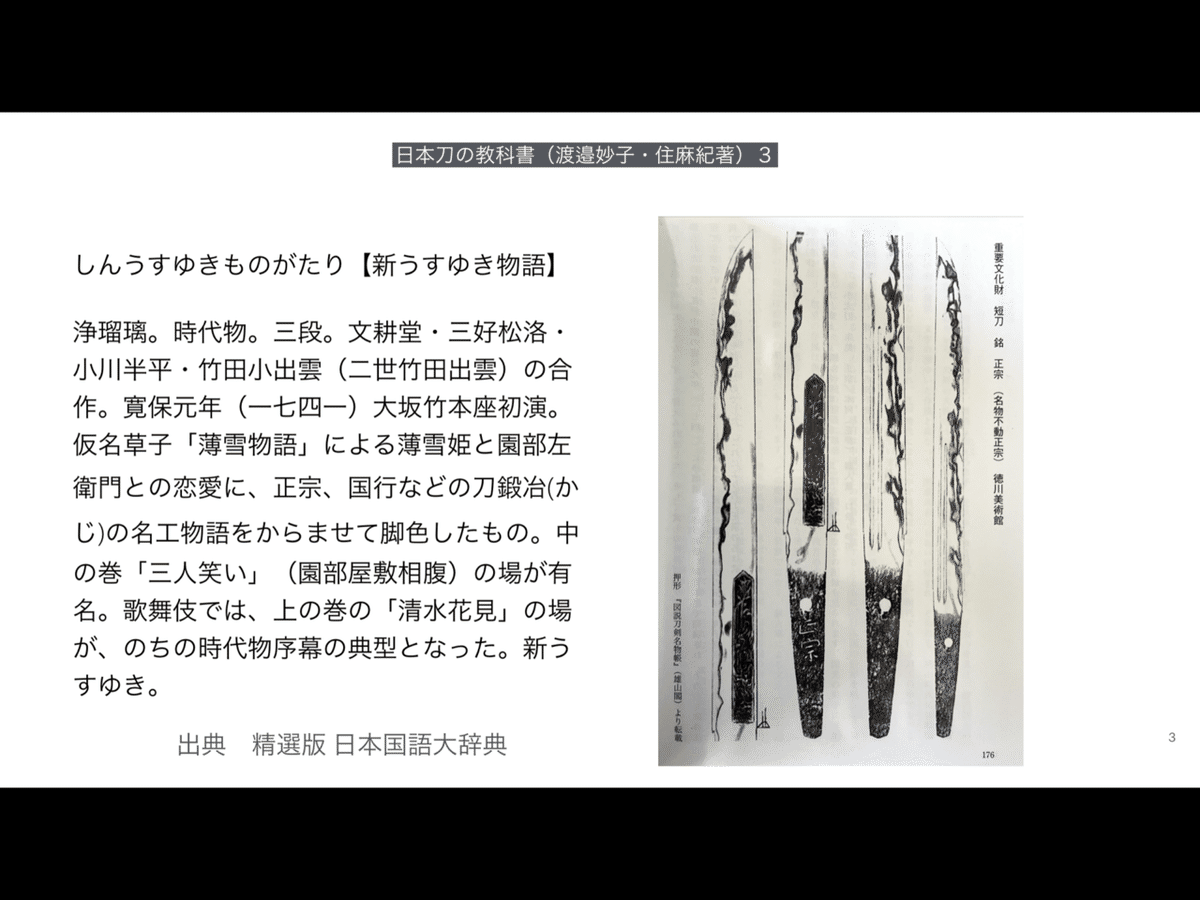天才正宗について
最近知り合ったアメリカ人との交流で「天才正宗」について紹介する事になりました。と言っても私ごときが私見を述べるのではなく、古今の著名な日本刀研究者がどのように評価して来たのかを紹介します。みなさまのお目汚しになること覚悟の上です。
まず最初は、私の師でもある渡邉妙子氏の著書から見ていきます。
なお、DeepLで翻訳し修正したものをアメリカの友人に送ります。
I would like to introduce how the genius Masamune has been evaluated by prominent Japanese sword researchers of the past and present. First, I will start with a book written by Taeko Watanabe, who is also my teacher. Please note that the English text has been translated and modified at DeepL.
1 //日本刀の教科書// (渡邉妙子・住麻紀)
p174 五郎入道正宗
・鎌倉時代末期、相模国鎌倉の刀工で、大海の大波のうねりのような躍動的な作風を創作しました。これは、師である新藤五国光の粟田口派の整った直刃と違っています。この作風は坂東武者に大いに好まれ、桃山時代には信長や家康にも愛好されました。
・この作風の一因として著者が挙げているのは、師の国光が鎌倉幕府と強い絆を持っていたことで進取の作風を生み出したことです。また、同じく国光の弟子である越中則重が、奥州月山や舞草鍛治の流れを受けて大陸とは異なる鍛錬法を持つ事です。これは、鎌倉幕府が中国宋との貿易とともに日本国内の物資流通を促進し、越前から釘を調達したことを紹介しています。
・正宗の刀剣の彫物は密教系で、蒙古軍の襲来に対して祈祷にも用いられ、敵軍を摧破せんとする強い祈りがあったものと思われます。
・庶民に広く正宗の名が知られたのは、江戸中期の寛保元年(1741)に浄瑠璃「新薄雪物語」が竹本座で初演され、歌舞伎にもなったところが大きいようです。正宗の秘伝の伝承と実子貞宗の腕を切り落とす親の情愛が人々の涙を誘いました。
1 //Textbook of Japanese Swords// (Taeko Watanabe and Maki Sumi)
p174 Goro-Nyudo Masamune
Goro Nyudo Masamune was a swordsmith from Kamakura, Sagami Province, in the late Kamakura period (1185-1333), who created a dynamic style that resembled the undulation of a great wave in the ocean. This style differs from the well-defined straight blade of the Awataguchi school of Shintogo Kunimitsu, his master. This style was much favored by Kanto warriors, and was also favored by Nobunaga and Ieyasu during the Momoyama period.
The author attributes this style to the fact that Kunimitsu, had ties to the Kamakura shogunate, which led him to create an enterprising style. Another reason is that Kunimitsu's disciple, Etchu Norishige, had a different training method from the continental style, which was based on the Oshu-Gassan and Mokusa forging traditions. This introduces the fact that the Kamakura Shogunate facilitated the distribution of goods in Japan along with trade with the So Dynasty in China, and procured nails from Echizen.
The carvings on Masamune swords are esoteric and were used in prayers against the Mongolian invaders, and are thought to have been made with strong prayers to defeat the enemy army.
The name of Masamune became widely known to the general public in 1741, when the joruri play "Shin’usuyuki Monogatari" was first performed at the Takemoto-za theater, which became a Kabuki play. The story of Masamune's secret tradition and the affection of the parents who cut off the arm of their own son, Sadamune, brought tears to people's eyes.
Translated with www.DeepL.com/Translator (free version)



この記事が気に入ったらサポートをしてみませんか?
